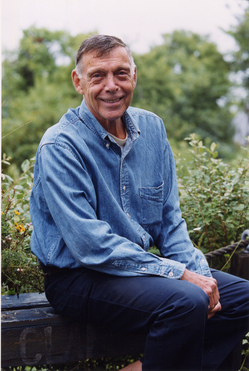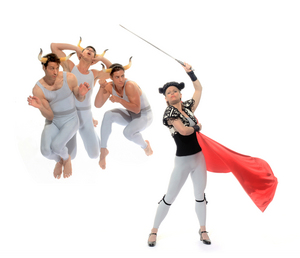Revered Paul Taylor bringing his modern-dance troupe to Power Center
Judging by the 1987 date of the autobiography on my shelves, the last time I talked with master choreographer Paul Taylor must have been 1985 or ’86. He was writing the volume “Private Domain” then, and I recall his dashing off during our phone call to quote the manuscript to me in response to a question.
In the 25 years since then, Taylor, now 80, could have written a second volume. It would include tales of making 90 dances since that time, for a grand total of 132, a total that is still climbing as his eponymous modern dance company, now a ripe 55 itself, undertakes a fall tour that includes three different programs and a family show at Ann Arbor’s Power Center Thursday through Saturday.

Paul Taylor
photo by Maxine Hicks
The Paul Taylor Dance Company concerts here are presented by the University Musical Society. Has it gotten any easier to make dances as the years have passed?
Not really, Taylor said in a recent conversation from New York.
“Each piece, in a way, before I start, I feel like I’ve never made a dance before,” he said. “It’s kind of scary, it makes me nervous. Then I go in and work with the dancers, and they’re so nice, and that passes.”
Taylor’s dancers are an extraordinary crew and a loyal one, and you hear a beam of patriarchal pride and contentment in Taylor’s voice when he speaks of them.
“There are so many years of these people coming and going,” he said fondly, “and most keep in touch with each other and keep in touch with me, and some come back and help with the revivals. And quite a few teach my dances to other companies or have their own companies.”
The current generation benefits from the wisdom of predecessors, and of course, they have the privilege of working with Taylor, the last person standing from that pioneering generation of modern-dance giants that included Martha Graham and Merce Cunningham. More than that, they are working with a choreographer whose dances, as he begins his ninth decade, are no twilight creations. As prolific as ever, he continues to win acclaim for the vibrancy, relevance and power of his recent dances as well as for his classics.
The shows here include dances in each category, with dances from every decade since the 1960s represented. It’s a terrific catalog of Taylor’s range — from sunny, open-hearted, pure movement explorations (the 1975 “Esplanade,” for example) to sizzling dances like “Piazzolla Caldera (1997) and darker explorations of subjects like religious fanaticism and hypocrisy in the 1988 “Speaking in Tongues.” Taylor’s dances are ever-changing in color and character.
PREVIEW
- Who: Modern troupe led by choreographic master.
- What: Three different programs of modern dances (specifics below), plus an afternoon family program. Also see below for related free events.
- Where: Power Center for the Performing Arts, 121 Fletcher Street.
- When: 8 p.m. Thursday-Saturday, plus a 1 p.m. Saturday family show that features University of Michigan dancers in Taylor’s “Le Sacre du Printemps (The Rehearsal)” and his company in “Also Playing.”
- How much: $18-$46 for the evening shows; $8 and $16 for the family show. Tickets from the UMS Ticket Office in the Michigan League, by phone at 734-764-2538, or online at the UMS website.
The oldest work on the program is the 1966 “Orbs” (Friday) — a grand exploration of the “seasons and the planets and the moons — very cosmic,” Taylor said — which the company is reviving this season. Taylor set the piece to Beethoven’s late string quartets — a decision he made without worrying about the place this music occupies in the Western classical music catalog.
“It should have been scary, but it wasn’t,” he said. “I was not familiar with them. I did not know that these last quartets were so revered, untouchable. And there were no complaints from the critics. We did the piece abroad first, in Vienna if I’m not mistaken.”
Taylor said he discovered the quartets on the advice of a “friend of a friend. “I don’t usually like Beethoven. I was surprised I liked them. I wanted to do the seasons — I had the idea for the dance first — so I went to Vivaldi’s ‘Seasons,’ you know, and I worked with it for a while. I got sick of it. I thought it was nice music, but it was not working; it wasn’t big enough. So I switched to the Beethoven”
With the dance “put away for quite some time,” as Taylor noted, bringing it back has been an endeavor that draws on sources live and archival.
Jennifer Tipton, the celebrated lighting designer, is recreating her lighting design for “Orbs” — the first of many Taylor pieces she’s worked on since. Rehearsal Mistress Bettie De Jong danced in “Orbs,” so she has body knowledge of the work — and so does Taylor himself.
“I remember in my body, my body remembers,” Taylor said. “And when I see someone else doing it, I can relate to it. I can’t get up and do it, but I remember it.”
“There were videos,” too, he added. “The piece was not notated, but I had notes and things, and the dancers look at those videos to learn it, and then Bettie steps in and puts it all together.”
Will he rework any of the steps?
“I don’t change things” as a general rule, he said. “You know, once in a long while, maybe a step … I’m so tired of looking at that thing and so I change it to something else. Just a tiny bit. Or I’ll do it for the dancers, change it to make it look better. Once a dance is finished, I don’t like going back and redoing. Let it be what it is; if it’s awful, let it be what it is.”
Letting things be what they are works well with Taylor’s dances. One of the striking things about them is their staying power, no matter the time of their composition or the period in which they are set.
You see this in several of the works planned for Ann Arbor, like the 2001 “Black Tuesday,” a dance set to Great Depression-era songs; “Speaking in Tongues;” or “The Word,” a dance about religious conformity from 1998.
“There are a lot of the dances are set in a specific time and place,” he said, “but you always hope that they will turn out to be universal.” But programming exigencies determine a lot of what the audience gets to see in a particular season, he added. “Usually I pick them to make balanced programs,” he said. “You’ll say, uh-oh, there are too many Bachs, or maybe we need something light and entertaining.”

Annmaria Mazzini with Orion Duckstein, Jeffrey Smith and Michael Apuzzo in "Also Playing."
photo by Tom Caravaglia
Light and entertaining, did you say? Well, no need to look back very far in the Taylor catalog. In fact, Op. 130, “Also Playing,” Taylor’s vaudeville-inspired dance from 2009, will do quite nicely. The dance figures on Friday’s bill of fare here.
If Taylor had the idea for “Orbs” before he found his music, it was the other way around for “Also Playing,” set to Donizetti ballet music. “The Donizetti I heard on the radio in the car, and I thought, that sounds kind of funny, you know? I wondered what could be done with it. It was a lot of very short pieces, I thought, like acts.”
It was a short hop from there to the idea of a vaudeville piece, which led to lots of research — fun research, watching old clips and finding things on the internet. “These internet things are a wonderful help these days. I can’t do them,” he said, “I can’t understand them. But there are several people in the office who do them for me.”
And was it hard for his dancers to find their vaudeville souls?
No, he said. “They just ate it up.”
It’s the norm for Taylor to invent the steps his dancers do, but he says he occasionally draws movement ideas from his dancers.
“I’ll ask them to do something, and they don’t do it the way I thought, and I like it better, and I keep it. The accident is more interesting than what I had thought of. And sometimes, I’ll say, ‘I just can’t think of a step right now, so I’ll turn the music on, and you all do anything you want.’ They love that, and I spot that little thing” that works, he said.
Taylor is reluctant to name favorite dances he has made. “That would get me in trouble. I try not to favor them,” he said, even though he admits to preferences. Like most artists, it’s the piece he’s working on now that is foremost in his mind. He just finished a new piece, he said. “We got to the end of the music. Now I’ll just go back and putter.”
Does he ever feel that he’s run out of material, or that he’s made his last dance?
“I’ve yet to feel that,” he responded. “You know, it always seems to me there are a limitless number of ideas for modern dances.”
Susan Isaacs Nisbett is a free-lance writer who covers classical music and dance for AnnArbor.com.

